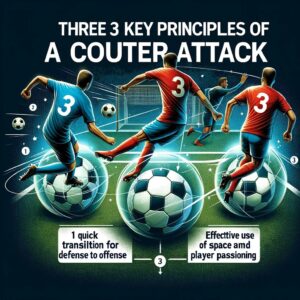Watching FC Barcelona in action, particularly their counter attacks, leaves fans in sheer amazement. This team has honed the skill of swiftly transitioning from defense to attack, making it a cornerstone of their gameplay. Their club is well known for executing fast moves with accurate passing, a testament to their strategic prowess in soccer.
I recall being captivated by their play during the 2020/21 FA Cup, where an impressive 14% of the 383 goals scored were a direct result of counter attacks. This statistic alone speaks volumes about the efficiency and effectiveness of their play style.
Shifting focus to a broader scale, a similar statistic is noticeable in other major tournaments like the UEFA Euro 2020/21. Observing these trends in recent years, it’s evident how pivotal counter attacks have become in modern soccer. They’re not just a tactic but an essential element of a team’s offensive arsenal.
As a soccer enthusiast, analyzing these patterns offers a deeper understanding of the game’s evolving dynamics. The reliance on quick turnovers and strategic forward thrusts has reshaped how teams approach both offense and defense in contemporary soccer.
What is a Counter Attack?
A counter-attack in soccer is a thrilling display of a team swiftly regaining possession and launching an attack against the opposition. This tactic combines speed and intensity, focusing on direct play and exploiting spaces behind the defensive line. As a strategy, it’s like watching a well-orchestrated dance where each player knows their role and the goal is to outmaneuver the opponent with precise coordination.
Counter-attacks can be broken down into four key phases: firstly, the Regaining of possession, which sets everything in motion. Following this, is Bringing the ball forward at a blistering pace, where players exhibit both skill and urgency. Then comes the Intelligent off-the-ball movement, crucial for creating opportunities and disorienting the defense. The culmination of a successful counter-attack is a High intensity approach, rounded off with a high-quality final ball.
In terms of chronology, the second and third points often occur simultaneously. This synchronization showcases the speed of thought of the player who regains possession and the instinctive running of their team-mates moving further up the pitch, who immediately sense the opportunity to strike. The beauty of soccer lies in these moments – a blend of individual brilliance and team effort.
Three Key Principles of a Counter Attack

In soccer, mastering the counter attack involves understanding and implementing three main keys. These principles are crucial not just for a few but for every single player on the team, across the board, regardless of the situation or level of play.
Speed of Movement
The first principle is the Speed of Movement. Counter attacking is a rapid, high-paced, and high-intensity element of the game. It requires players to exhibit high-speed movements, often transforming a defensive stance into an offensive onslaught in a blink. This speed is not just physical but mental too, demanding quick decision-making as the game’s momentum shifts.
Passing Precision
Passing Precision is the second key principle. When players are moving at such a rapid pace, often sprinting down the field, the accuracy and timing of their passing become even more important. A well-timed and accurately delivered pass to the right spot can make the counter attack successful, whereas a bad pass can cause it to break down.
Dedication and Commitment
Finally, Dedication and Commitment are indispensable. This principle dictates that during a counter attack, every single player on the field needs to be fully engaged. It’s about not giving up, pressing the opposition, and continuously moving forward. The lack of dedication or commitment from even one player can undermine the entire team’s effort.
How Does a Counter Attack Work?
A counter attack in soccer is a fast-paced attacking move, where a team, after regaining possession of the ball from the opposition, swiftly transitions into an offensive mode. For example, imagine a scenario where a central defensive midfielder (CDM) makes a clean tackle and then pokes the ball to the attacking midfielder. Subsequently, the attacking midfielder executes a through-ball to an inverted winger, who slashes through the middle to score a goal. This entire sequence unfolds while the defensive team is forced to track back, having been caught off guard during their own offense.
However, it’s not always “Better to Go Slow to Go Fast”. A counter attack is not always the best option. It requires a good understanding of the game and the ability to quickly recognize when to launch an effective offensive. If the opposition has a strong defensive structure, a hasty counter attack might not be effective. In such cases, a team may opt for a slower build-up play, methodically crafted to break down the opposition’s defense.
The effectiveness of a counter attack depends largely on the team’s adaptability and tactical acumen. Recognizing when to unleash a rapid offensive and when to hold back for a more measured approach is crucial. Balancing aggression with strategic planning can turn the tide of a game, making counter attacks a potent weapon in a team’s arsenal.
How to Defend Against a Counter Attack?
Defending against a counter attack is just as important as identifying and taking advantage of one. While counter attacks don’t typically happen often, they can rapidly lead to a goal if not addressed properly. Effectively defending against them requires quick thinking and great positioning.
Key Strategies for Effective Defense
To start, Stay organized is crucial. When your team is in possession of the ball, everyone must maintain their proper defensive positions. This organization is vital to quickly transition into a defensive mode. Close down space effectively against the opposing team. This involves limiting the room they have to work with by pressuring the ball and cutting off passing lanes.
Communication and Teamwork
Communicate constantly. Communication is key in synchronizing the team’s efforts. Ensure everyone is talking and letting each other know where the opposing players are positioned. Remember, it’s not just the job of the defenders; Defend as a team. The entire team needs to work together to prevent the opposing team from scoring.
Patience and Quick Reactions
Be patient and avoid the urge to dive in recklessly. A mistimed challenge can miss the ball and leave your team vulnerable to a quick goal. Instead, Get a foot on it; even a minor toe-poke can disrupt the offensive team’s momentum. Sometimes, this quick intervention can even lead to a counter attack from a counter attack.
How to Practice the Counter Attack with Your Team?
Developing an effective counter attack is a vital soccer skill that doesn’t just magically happen. It’s a team tactic requiring coordinated work during team training. Teams need to practice regularly, and each player must understand their responsibilities in a counter scenario.
Remember, speed is the key in executing a counter attack, complemented by precise one and two-touch soccer. To hone this, practice using a long switch or diagonal passes that can effectively cut through lines of defenders. A focus on quick, fast running while working on precision passing is crucial.
Incorporate drills where your team changes from a defensive position to an immediate attacking position. This simulates real-game scenarios where a counter attack can happen anywhere on the field as soon as your team regains possession. First, players must learn to win the ball defensively.
Teach players to Realize the time and space they have to go forward, especially with defensive numbers behind them. When your team wins the ball back defensively and recognizes that the opponent is unbalanced, it’s time to take advantage of the counter attack. This awareness and timely reaction can turn defensive actions into offensive opportunities.
Conclusion
Mastering the art of the counter attack in soccer is a multifaceted process that involves speed, precision, and tactical awareness both individually and as a team. It’s not just about the physical aspects but also understanding the strategic elements of the game.
By practicing specific drills, focusing on quick transitions from defense to attack, and nurturing a keen sense of awareness on the field, teams can effectively turn defensive scenarios into goal-scoring opportunities. Emphasizing these aspects in training can transform a team’s counter-attacking capabilities, making them a formidable force on the soccer field.
Frequently Asked Questions
What is a counter attack example?
A counter attack example in soccer is when a team quickly transitions from defense to offense, often after regaining possession. For instance, a team intercepts the ball in their half and swiftly moves it upfield, leading to a scoring opportunity against an unprepared defense.
How do you counter attack?
To execute a counter attack, a team must quickly regain possession and exploit the opposition’s vulnerabilities. This involves fast-paced movement, precise passing, and strategic positioning of players to swiftly transition from a defensive stance to an attacking one.
What is counter attack team in football?
A counter attack team in football is a team that excels in swiftly transitioning from defending to attacking. These teams are known for their quick, direct play and ability to exploit spaces left by the opposition, often catching them off guard with rapid offensive moves.
What is quick counter in soccer?
A quick counter in soccer refers to a rapid and direct offensive play immediately following the regaining of possession. It’s characterized by high-speed, coordinated movement towards the opponent’s goal, often involving few touches and utilizing the element of surprise.
How do you beat a counter attacking team in soccer? T
o beat a counter attacking team in soccer, maintaining a solid defensive structure is crucial. Teams should focus on controlled possession, minimize spaces for counter attacks, and ensure balanced positioning of players to reduce the risk of being caught off guard during transitions.

